This is an Anscomark M 35mm rangefinder camera made in 1960 by Riken Optical Co., Ltd. (Ricoh) for GAF USA who at the time distributed cameras in the United States under the ANSCO brand. The camera was developed by Riken for GAF in exchange for some of it’s photocopier technologies. The Anscomark M was a very well equipped camera featuring interchangeable lenses, a coupled coincident rangefinder, coupled selenium exposure meter, and a very unique design.
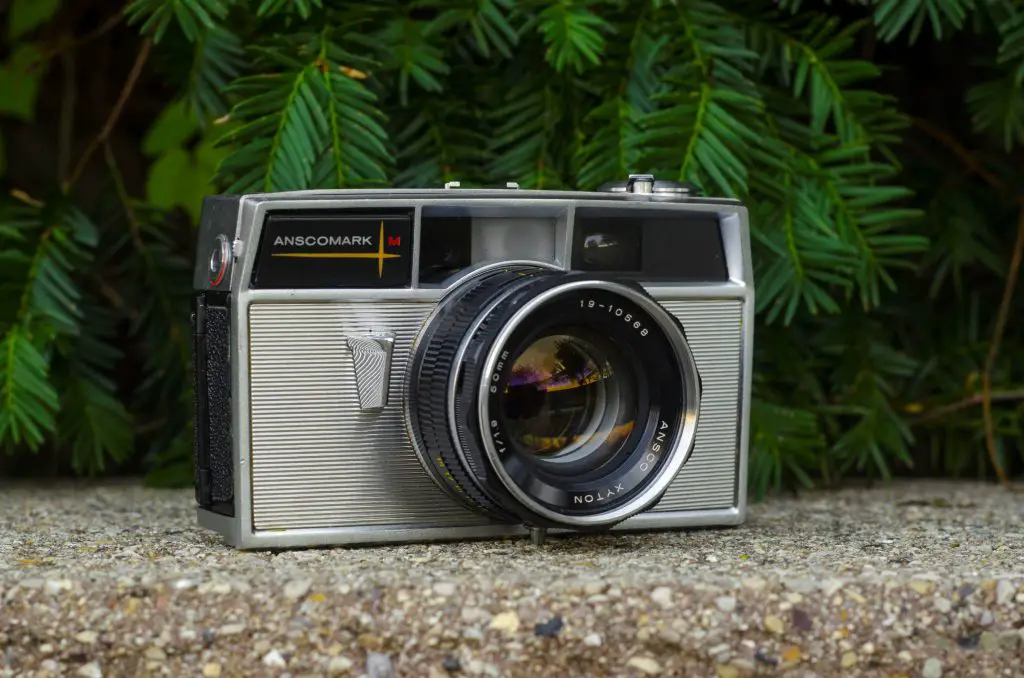 Film Type: 135 (35mm)
Film Type: 135 (35mm)
Lens: 50mm f/1.9 ANSCO Xyton coated 6-elements
Lens Mount: Anscomark M Bayonet
Focus: 3 feet to Infinity
Viewfinder: Coincident Image Coupled Rangefinder with 35, 50, and 100 mm Color-Coded Projected Brightlines
Shutter: Seikosha SLV leaf
Speeds: B, 1 – 1/500 seconds
Exposure Meter: Coupled Selenium Cell w/ top plate match needle
Battery: None
Flash Mount: Hotshoe and M and X Flash Sync
Weight: 988 grams
Manual: http://www.cameramanuals.org/agfa_ansco/ansco_anscomark_m.pdf
Manual (Accessory Lenses): http://www.cameramanuals.org/agfa_ansco/anscomark_lenses.pdf
How these ratings work |
The Anscomark M is one of the most distinct looking cameras in my collection. It has combination of features that limits it’s competition to only a few models, and when combined with one of the excellent lenses that were made for it, it rewards you with some spectacular photos. The designers of this camera made some curious ergonomic choices, but none of them detract from the overall experience of using it. I found the Anscomark M to be a fun camera to shoot, and one that consistently gave me many excellent photographs. I highly recommend this camera for anyone looking for something different. | ||||||
| Images | Handling | Features | Viewfinder | Feel & Beauty | History | Age | |
| 2 | 0 | 2 | 2 | 2 | 1 | 20% | |
| Bonus | +1 for indescribable cool factor, this is one of the most unique looking cameras ever made | ||||||
| Final Score | 11.8 | ||||||
History
The Anscomark M was a very unique looking 35mm rangefinder made for a short while starting in 1960 by Riken Optical Co., Ltd. (Ricoh) of Japan. The camera was designed for and sold primarily in the United States, but Riken marketed a small number of cameras in Japan as the Ricoh 999. Other than the name, the two cameras were identical.
In the 1960s, the company whose name makes up the first 5 letters of the camera’s name, ANSCO, was a subsidiary of a German company called General Aniline & Film Co., or GAF for short. The history of this company is quite long and complicated, and a really excellent timeline compiled by William L. Camp can be viewed here. Here is an abbreviated version.
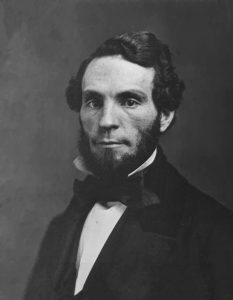
In 1842, a Columbia University graduate named Edward Anthony opened a daguerreotype gallery in New York city called E. Anthony & Co. Anthony sold daguerreotype chemicals and supplies, but eventually started to manufacture his own cases and other accessories. In 1852, he was joined by his brother Henry T. Anthony and the company was named E. & H. T. Anthony & Company.
Over the course of the next few decades, the Anthony brothers did very well, growing their business to a point in which they claimed to be the largest photographic chemical and apparatus manufacturer in the world. They had a large retail distribution business and made all sorts of camera equipment and photo developing chemicals using all the latest processes. In 1883, the company built the world’s first mass produced instantaneous camera, called the Schmidt Patent Detective Camera.
In 1902, E. & H. T. Anthony & Company would merge with the Scovill Manufacturing Company out of Waterbury, Connecticut who had been in business since 1802. The merged company became the Anthony & Scovil Company, or ANSCO for short and they moved their headquarters to Binghamton, NY. The newly merged company was now the second largest photographic film and camera maker in the United States, right behind the Eastman Kodak Company.

Throughout the first few decades of the 20th century, ANSCO remained a film first company, but in 1924, would release their first camera, the Automatic ANSCO. Four years later, in 1928, the company was bought by the German company AGFA (some sources say they merged, but it’s not 100% clear who was the controlling interest).
In 1939, the parent company of AGFA-ANSCO was renamed to General Aniline & Film Company, or GAF for short. GAF was a large multi-national organization whose products extended into the chemical business, one of which was the parent company of Bayer aspirin. GAF would have it’s hand in a large number of other industries as well. Later that same year, AGFA-ANSCO officially became a subsidiary of GAF.
Over the course of the next few decades, the two companies operated under the name AGFA-ANSCO and would begin a partnership of releasing nearly identical cameras under both names. Some of the cameras sold in the United States were copies of existing AGFA models, but actually made in the USA, and some were directly imported from Germany.
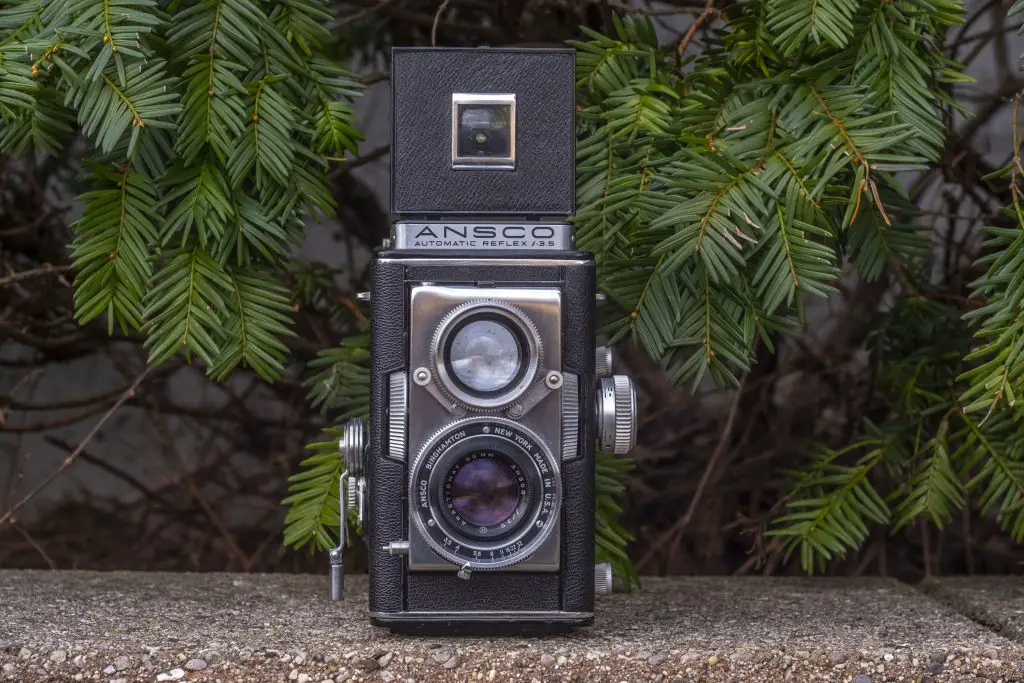
With few exceptions, very few of ANSCO’s cameras were designed or manufactured in the United States by the American branch of ANSCO. It would seem that ANSCO continued to operate as a film first company, and would primarily sell models made by other companies, with their name affixed to them. One notable exception to this was the ANSCO Automatic Reflex 3.5 TLR from 1947 which was built in response to an inability to get quality twin lens reflex cameras out of Germany after the war.
In the late 1950s, one of GAF’s other businesses was making photo copiers, and they had pioneered a new method of copying documents using something called a “Dry Diazo Process”. Prior to the dry process, the method for making photocopies involved wet ink which was slower, took time to dry, and was prone to smears. While I won’t pretend to know much about how these early photocopiers worked, my guess is the dry method is similar to modern “toner” in which a dry powder is used to make a duplicate of an original.
It was around this time that Riken Kōgaku Kōgyō K. K. (later known as Ricoh), had been investing in photocopier technology and was interested in GAF’s dry process. ANSCO was looking to expand it’s camera offerings beyond entry level German cameras, so a deal was made. Riken would receive GAF’s technology to produce photocopiers using their dry process, and in exchange, Riken would produce cameras specifically for the American market that would be sold as ANSCO cameras. The first camera part of this deal was the Anscomark M.
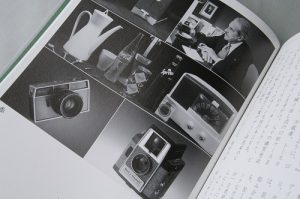
Manufactured in Japan by Riken, the Anscomark M was designed by famed American industrial designer Raymond Loewy. Loewy was responsible for the designs of a huge number of products from the 1920s through the 70s. He came up with designs for Boeing airplanes, automobiles and trucks made by Studebaker and American Harvester, locomotives, appliances, electric razors, and even designs of the famous Coca-Cola bottles and cans. His influence on corporate and consumer products in the middle of the 20th century was significant, so it was likely considered a great honor to have him design a Japanese camera specifically targeting the American market.
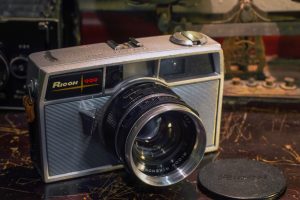
The Anscomark M was sold exclusively in the United States, but Riken sold their own version of the camera in Japan as the Ricoh 999. Other than the name, the camera was identical to the American version. With a list price of ¥33,800, the camera was aimed at the advanced amateur market. Production numbers for the Ricoh 999 must have been very low as they very rarely show up on the used market today. My best guess is that the relatively high price, and strong American styling did not win over many Japanese customers.
In the United States, the Anscomark M fared slightly better. It had a list price of $134.50 with the f/2.8 Xytar lens, and $159.50 with the f/1.9 Xyton. When adjusted for inflation, these prices are comparable to $1130, and $1340 today.
The following three pages came from a 1960 ANSCO dealer notebook showing off the camera’s many features, plus an interesting presentation kit that a camera dealer might have wanted to put on display to show off the new camera.
The below gallery shows 4 advertisements for the Anscomark M from 1960 – 1961.
Sales were likely slow as the camera’s relatively high price, unique design, and the fact that consumers weren’t used to spending top dollar on an ANSCO product, prevented them from being top sellers. The relative obscurity of these cameras today and the lack of any other Anscomark model confirms this. In an effort to boost sales, a June 1961 advertisement in U.S. Camera suggests that with every purchase of an Anscomark M camera, you would receive 10 rolls of 20-exposure Anscochrome film, and a $10 coupon that could be used to buy one of the other accessory lenses.

For whatever reason this camera didn’t sell well, it wasn’t because of the quality of the images it could make. The Anscomark M and it’s Riken built Xyton and Xytar lenses were very good. The camera supported nearly every feature found on mid to high end rangefinder cameras, including interchangeable lenses, a large and bright viewfinder, coupled selenium light meter, and a wide spread of shutter speeds.
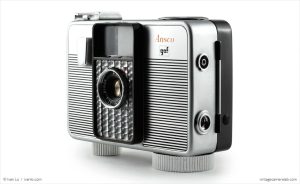
I could not find any information about exact production numbers, or how long it was made, but it seems to have disappeared from advertisements by 1961, so a production run of less than 2 years is likely. ANSCO’s agreement with Riken would produce at least one more camera, the ANSCO GAF Memo II Automatic in 1967, which was a rebadge of the Ricoh Auto Half.
Today, there is limited appeal to the Anscomark M. This likely due to lack of information about it rather than anything to do with the camera itself. I became aware of this model after collecting cameras for a couple of years, so it’s likely there are many others out there who would be interested in this camera, but just don’t know about it. The design of the Anscomark M is unlike any other made, it is a well built and heavy camera, with a lot of features that for the time made it quite competitive, and the lenses made for it were very good.
My Thoughts
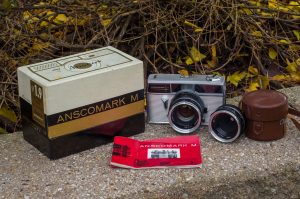
By the time 1960 had rolled around, the standard for what a 35mm rangefinder should look like had already been established. There should be a chrome (or black) top plate, black leatherette or vinyl body covering, top right lever wind film advance, viewfinder in the middle or left of the back of the camera, rewind lever, accessory (or flash) shoe on top, an exposure counter of some type, and in the case of metered cameras, some kind of meter readout on top.
Then came the Anscomark M. Resembling more like an American automobile than a Japanese camera, the Anscomark had a prominent grille on the front of the camera, sharp edges, a chrome plated front body covering, and a black trim piece across the back of the camera which somewhat resembles the dashboard of a car.
Beyond the cosmetics, the next thing you’ll notice the first time you handle an Anscomark M is how heavy it is. With the f/1.9 Xyton lens mounted, the camera weighs a substantial 988 grams (2.18 lbs). With a roll of 36 exposure of Ektachrome installed, the camera exceeds 1000 grams, heavier than many TLRs! Perhaps it was Loewy’s previous experience designing locomotives, automobiles, and large appliances which made him unfamiliar with modern weight saving alloys like aluminum and plastic. The weight and many sharp corners of this camera make this one you’d definitely not want to drop on your foot without any shoes on!
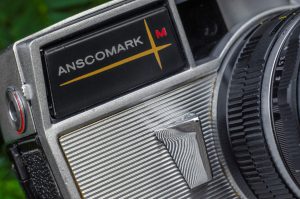
Thankfully, handling the camera is not impeded too much by it’s bulbous size and weight. The front mounted, chrome plated, triangular shutter release is comfortably located in a position that your right index finger can easily find. Using a front shutter release was a smart move as I think that had there been a top plate shutter release, it would have been impossibly difficult to reach while supporting the camera. For those situations where long exposures are needed, the shutter release is threaded for a shutter release cable on the bottom.
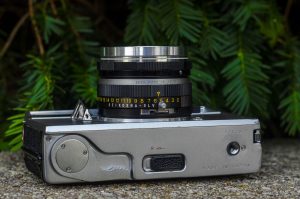
The Anscomark M is a bottom winder, keeping with the fad in the late 1950s and early 60s with bottom winding cameras made by Kodak, Balda, Canon, and even Ricoh. It is strange though that being built by Riken, it lacked the company’s trademark “trigger wind” system that was featured on their 500-series cameras. Perhaps this was a feature they wanted to keep only for Ricoh branded cameras.
Whatever the reason for the more traditional wind lever, this is one area of the camera in which function took a back seat to design. The wind lever is one of the shortest I’ve seen on a camera of this size, and it’s rotation of less than 180 degrees means that there is a tremendous amount of torque on take up spool and film when winding the camera. This means that the film perforations (the sprocket holes) are more likely to tear or become damaged if a lot of force is applied to the wind lever. Because of this, I strongly recommend winding the Anscomark slowly, especially if you are using a thinner film. I think that in this case, making the Anscomark M a double-wind camera would have really helped here.
Also on the bottom of the camera is the the tripod socket, and what looks to be a door release is actually the rewind release switch for when you reach the end of a roll of film. I’ve never seen a rewind switch designed like this, but it serves it’s purpose fine. The actual door release catch can be seen on the far edge of the base plate, next to the tripod socket.
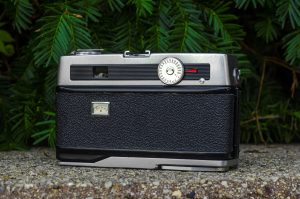
The back of the camera extends the automotive-inspired design with a rear trim across the viewfinder eyepiece and film speed ASA dial that somewhat resembles an automobile dashboard.
On the actual film door is something you don’t normally expect to find, which is the automatic resetting exposure counter. The counter is quite elegant, resembling a fuel gauge of some type with a red mark that points to the number of exposures made on the camera. The counter counts upward starting at “S” all the way to 36 with actual numbers every 5th exposure.

The ASA dial has a very large number of film speeds, starting at 4, all the way to 800. Some of the numbers are quite odd, like 40 and 650. Who has ever seen a 650 speed film?
The small screw to the right of the ASA dial is a calibration screw for the meter to zero it out in the event that it starts returning erroneous readings.

With the wind lever, exposure counter, and shutter release on other areas of the camera, the top plate of the Anscomark M is quite barren. This is exaggerated by the large size of the camera. Featuring only the rewind knob, flash hot shoe, and meter readout, there is plenty of room for the large Anscomark M logo.
Also visible on the lens barrel while looking down at the top of the camera are the readouts for flash sync, self timer, shutter speed, aperture setting, and the focus ring with a depth of field scale. The Anscomark M is an interchangeable lens camera, so it makes sense to have the aperture and focus rings farthest out from the camera as these are both unique to each lens.
Another plus to the arrangement of the dials is that if you use Sunny 16 while shooting the Anscomark M like I do with many vintage cameras, you are generally going to set the shutter speed to match the film speed in the camera and leave it there, only changing the aperture to match available light. With the shutter speed closest to the body, you can set it to your chosen speed, for example 1/125, and reach for the aperture ring each time you need to make a change. I find this arrangement to match my style quite well.
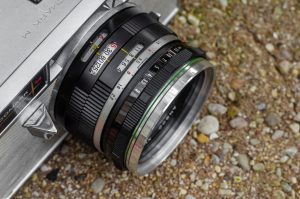
The viewfinder on the Anscomark is like those on other interchangeable lens rangefinders like the Canon P and Nikon S3 which offer projected frame lines for 3 different focal lengths, but unlike those other cameras, the frame lines are color coded to match the lines to a stripe on the available lenses. The 50mm lines are white, 35mm lines are green, and 100mm lines are red. Each of the white, green, and red lines have matching white, red, and green stripes on the front edge of the corresponding lenses. In the image to the left, you can see the green stripe for the Xytar 35mm lens which is mounted. If you look at the image of the top plate of the camera above, you can see the white stripe from the 50mm lens. I did not have the 100mm telephoto available for this review.
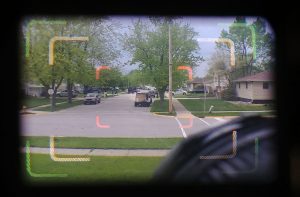
I’ve never seen a color coded system like this for easily remembering which focal length you are using, but I also have to wonder how it often it would have been used as I imagine that either of the two 50mm lenses were the ones most commonly mounted to the camera.
The viewfinder itself is large and bright with a contrasty and easy to see circular coincident image rangefinder patch. None of the frame lines have automatic parallax correction, but instead have little notches in the corners to indicate close focus distances. A side effect of the large and also large Xyton lenses, is that the lens barrel is visible through the viewfinder and blocks the lower right corner of your view.
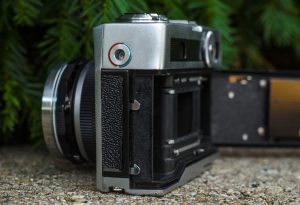
On the bottom of the camera’s left side is the release for the door (which you can also see above in the image of the bottom of the camera) and one of the most unique detachable strap lugs I’ve ever seen on a camera.
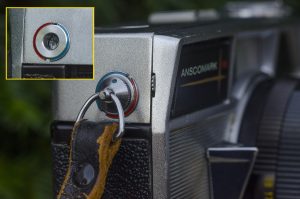
If you look carefully, the strap lug socket has a red line along one half, and a blue line on the other. These colored lines are meant to indicate whether the strap is secured to the camera (blue), or loose (red). The strap lug itself has a blue dot that can be rotated to lock and unlock the strap lug.
I found this to be a really cool feature of the camera that is barely mentioned in the camera’s user manual. I actually missed it the first few times I read through it as it’s only mentioned in the “ANSCOMARK M Carrying Case” section on page 20. I like the idea of a detachable strap as I don’t always like to use a strap, but when I do, it can sometimes be an arduous process to thread one back onto a camera. Of course, a huge con to this system is that if you lose the removable lugs that go into this socket, you can’t attach a strap to the camera at all. I am sure finding replacement lugs wasn’t easy back in the 1960s, and is nearly impossible now. A quick eBay search of recently sold Anscomarks returned 6 cameras, 5 of which I could clearly see the lugs were missing, and in the 6th one, I couldn’t conclusively see the sides to tell.

If you are fortunate to have one of the auxiliary lenses for the Anscomark, changing the lens is quite simple, but not obvious if you’ve never done it before. Looking at the bottom of the lens mount is what looks to be a little kickstand which supports the camera when sitting flat on a table. This kickstand also doubles as the lens release.
With the camera in your right hand, lens facing up, and the bottom of the camera facing your palm, use your right thumb to apply downward pressure on the kickstand, then with your left hand, rotate the lens counterclockwise to remove it.
Reattaching the lens is simple as well. Line up the red dot on the back of the lens mount, to the red painted screw on the camera and rotate it clockwise until it clicks. In the event the paint has wore off the screw, it is the screw nearest the shutter release.
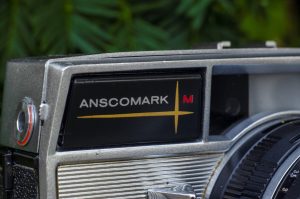
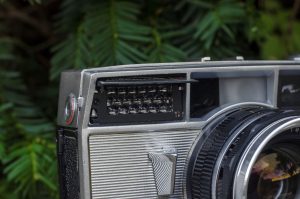
The selenium cell exposure meter is behind the “Anscomark M” door on the front of the camera. Unlike other cameras with covered meters with dual range modes where the door has some slits to allow some light through, the Anscomark only allows light to pass to the meter with the door in the open position.
A side benefit of this, is that since selenium meters have a better chance of surviving decades of use if they’re kept in darkness, there is a better chance to find one of these cameras with a working meter. I have had the chance to handle two different Anscomark bodies and both had working meters. Whether I am just incredibly lucky, or these are more often found working is anyone’s guess.
The meter is coupled to both the ASA film speed dial on the back and the shutter and aperture rings on the camera. It works like a typical match needle system in which the needle moves based on available light and you must make changes to get the needle to fall in between a “C” shaped arm that you control.
There is no auto exposure here, and the only readout for the meter is on the top plate of the camera, so if you want to skip the meter (or if yours doesn’t work), you can use an external meter with EV (Exposure Value) readings as the Anscomark has this feature too.
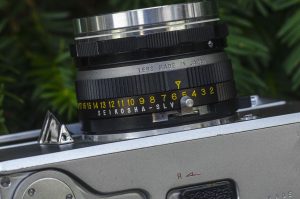
Like typical cameras from the era, the lens has a range of EV numbers from 2 – 18, and by using an external meter with these same numbers on it, you match up the EV number on the camera with that of the meter for proper exposure. There are various combinations of shutter speeds and f/stops that will equal the same EV number, so you would just choose whatever combination best suits the situation you are shooting in. I am generally not a fan of EV systems like this, and it’s position opposite of the displayed shutter speeds and f/stops suggests that Riken didn’t really think many people would use it either, but it’s a nice option to have if you need it.
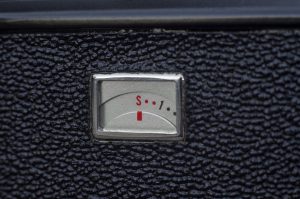
In use, there’s no way of getting around the Anscomark’s large size and weight. The edges are sharp, the lens blocks a portion of the viewfinder window, and the wind lever could have been designed better. On any other camera, each of these “cons” would detract from the overall experience, but that’s not the case here. Maybe I’m just so enthralled with the looks of the camera that I can’t see the camera’s many faults, or maybe the camera does so many other things well that these faults end up not being that big of a deal.
Now that we know the camera is stunning, and has quite a few interesting ergonomic choices, what kinds of photos is it capable of? Riken was certainly no stranger to good optics, so did they maintain that for this American-ized rangefinder, or did they “phone it in”?
My Results
My first opportunity to shoot the Anscomark was on a trip last fall to northern Michigan. Not knowing what types of results I would get from the Anscomark, I wanted to develop the film myself so I chose a roll of black and white film. I have since acquired the chemicals to do my own C41 processing, but I could only develop B&W when I first got this camera, so I went with a roll of Kodak TMax 400. In any case, as soon as I got home, I quickly ran into my basement and developed the film in HC-110.
To say I was impressed is an understatement. I have been pleased with results from Ricoh cameras in the past, most recently with the excellent Ricoh 519M, but I was stunned at not only the sharpness of the Xytar lens, but the contrast, coverage, and detail in the images. I knew I had to shoot color, and FAST. Sadly, winter was approaching. Colors are hard to come by in my area of the country during the winter months, so as much as I hated to do it, I shelved the Anscomark and decided I would wait until spring before shooting it again.
As usually happens every year, winter took it’s sweet time to leave the northwest Indiana area where I live, but when I did, I eagerly got out some color film and decided I would go for something good. For the Anscomark M’s inaugural color roll, I chose a slightly expired roll of AGFA Ultra 100 film and shot it around my neighborhood.

As was the case with the TMax images earlier, the images I got in color were absolutely splendid. Unlike lesser cameras, the Anscomark’s images have a near digital look to them. I noticed no distortion, vignetting, chromatic aberrations, or any other lens anomalies that often plague lesser lenses. AGFA Ultra is (was) an excellent film with natural colors and minimal grain, but it was clear this was a perfect match for the sharpness of the Anscomark’s lenses. I shot about half of these with the 35mm wide angle, and half with the 50/1.9 Xytar. I’ll be honest, I can’t remember which of these was which, but they’re all sharp and beautifully rendered.
I spoke earlier about the camera’s large size and ergonomic quirks, but none of them caused me any difficulty while out shooting. I relied on the exposure meter most of the time and thankfully found it to be pretty accurate. On occasion, I would bump the ASA film speed dial on the back causing the meter to be set to a different value, so that was something I needed to be mindful of.
The large and bright viewfinder was very easy to compose with and the colored frame lines did not clutter the viewfinder as is the case on some of the more “ambitious” rangefinders that have been made.
When testing and reviewing cameras, there is often a short lived love affair with a particular model in the time you are using it, but reality eventually sets in after it sits for a while. With the Anscomark, I ended up shooting two rolls through the camera nearly 6 months apart and I can tell you that my excitement for the camera never faded between the two. This is a special camera with a look that sets it apart from pretty much any other camera ever made. Sure, it’s not perfect, but it doesn’t have to be. It’s certainly not better in any one regard to anything else in my collection, but when you combine it’s gorgeous styling, unique feature set, excellent build quality, and amazing lenses, the Anscomark M becomes an easy favorite. I thoroughly enjoyed using this camera and I loved the the results. They don’t show up for sale often, but the next time one does, I strongly recommend you give it a chance!
Related Posts You Might Enjoy
External Links
http://camera-wiki.org/wiki/Ansco_Anscomark_M
http://vintagecameralab.com/ansco-anscomark-m/
https://www.photo.net/discuss/threads/the-anscomark-m.465197/
https://www.flickr.com/groups/2022747@N22/
https://plaza.rakuten.co.jp/gratt/diary/200601210001/ (in Japanese)
http://www.collection-appareils.fr/x/html/camera-15472-Ansco_Anscomark%20M.html


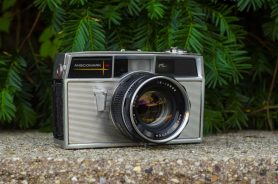

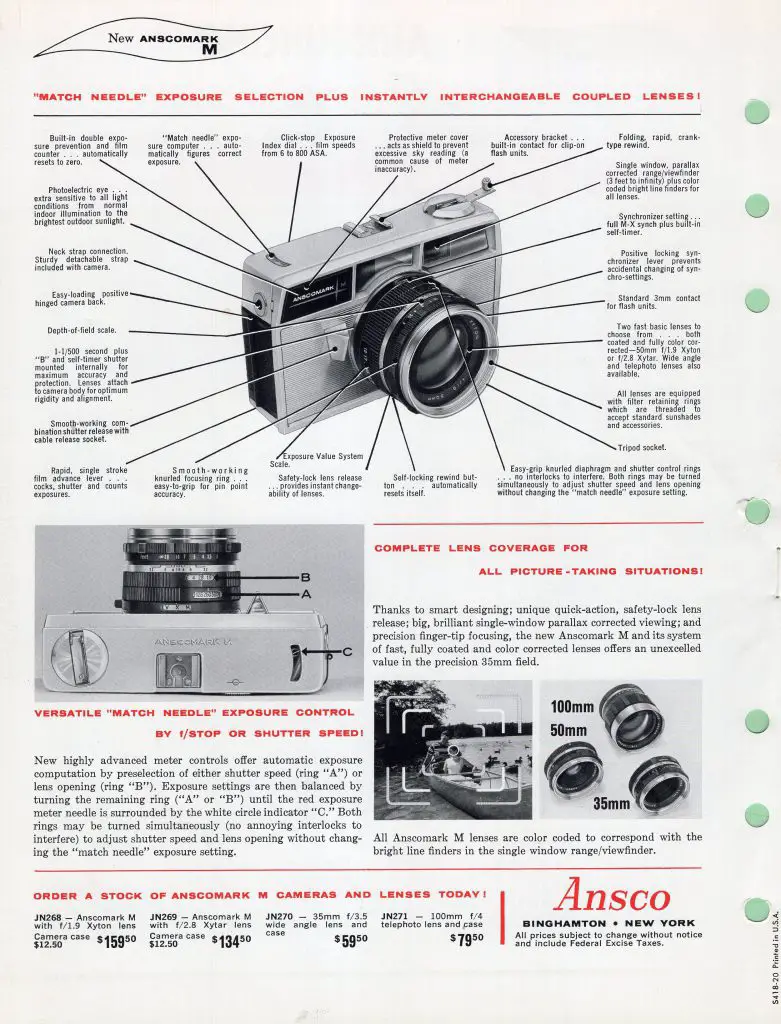
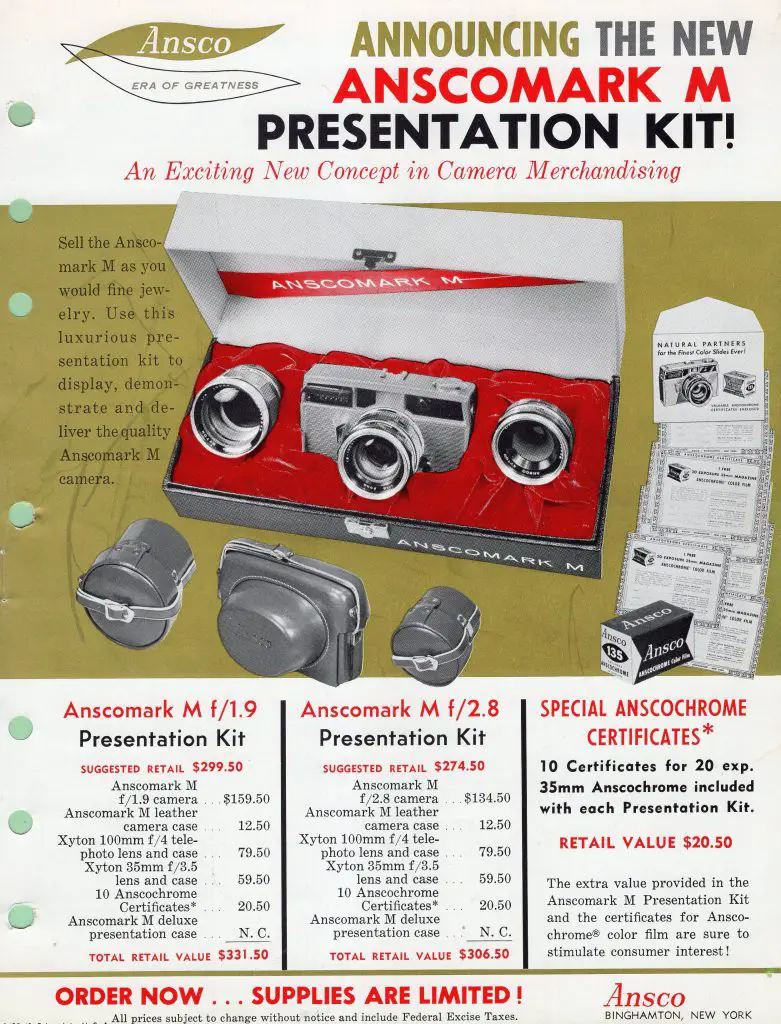




















I love it when I see a thorough review of a camera I have never seen before. You certainly have a gem there, and at first glance it looks a bit Argus-like. The images look great, too. Thanks for sharing!
Thanks for the kind words, Mark. I suspect a lot of people are unfamiliar with this camera, but its truly a gem! I highly recommend picking one up if you ever have the opportunity.
I just picked one up at an estate sale as an add on freebie to two others cameras I was purchasing. It has all three lenses and cases AND the meter works! Can’t wait to give it a try. Excellent and helpful write up.
Very cool! I love my Anscomark M. My best piece of advice would be to be mindful of the film advance lever. It’s very “torquey” and can damage thin films if you’re rough on it. Otherwise the lenses on those are really terrific!
I’ve shot numerous rolls through at this point, and it’s a gem to use. Looks odd, but is strangely ergonomic. The 100mm gives good results, but like you I kept the 50 on most of the time. This one is a definite keeper.
Ive shot probably 50/50 between the 50mm and the wide angle 35mm. I haven’t come across the 100mm let, but would love to try it out someday. Although it’s a completely different camera, I recently shot a roll of film using a 135mm lens on the Kowa SET-R and loved the extra reach it provides! Of course telephoto lenses on rangefinders are a lot different than an SLR. Glad you liked the review, and the camera though as many people have never heard of the Anscomark!
OK Mike one has come up for sale close to me for 100 dollars, I’ll go look at it. Hard to believe that it can be heavier than my Konica IIIA
The Anscomark is a fantastic camera, but you can find them cheaper than $100. Maybe I’d pay that for one in great shape with all of the accessory lenses, but unless that seller is willing to negotiate, for me, thats a bit too much to ask.
Mike, from the 2 pictures in the ad it looks clean, leather case and lens tubes look excellent, here’s hoping that it is all in excellent shape. Time will tell-going on Mon to look at it. I would like to use it for B&W.
Well I got it. The camera is in fine shape,I received a 35/3.5, 50/1.9, 100/4 lenses, and filters for all three. One leather tube, and the leather case (it is old and in need of some repair) I think I will run a roll through it and see how it goes.
Mike, I am not in love with the camera..preferring my Konica IIIA. Would you be interested? I have all three lenses, can give you some good detail images if you wish.
Randy, Long shot here. I’d be interested in your camera if you still have it and it’s for sale!
What an unusual and exciting camera! It is certainly on my radar now; I hope I’ll find one in good condition sometime.
It’s definitely a neat camera, and while not super common, it’s also not so rare that they’re impossible to find. Just keep your eye out on eBay and they do turn up from time to time.
Do you happen to know what size filter the 50mm f1.9 takes?